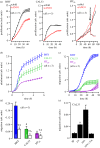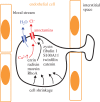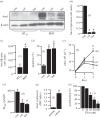Role of anoctamins in cancer and apoptosis
- PMID: 24493744
- PMCID: PMC3917350
- DOI: 10.1098/rstb.2013.0096
Role of anoctamins in cancer and apoptosis
Abstract
Anoctamin 1 (TMEM16A, Ano1) is a recently identified Ca(2+)-activated chloride channel and a member of a large protein family comprising 10 paralogues. Before Ano1 was identified as a chloride channel protein, it was known as the cancer marker DOG1. DOG1/Ano1 is expressed in gastrointestinal stromal tumours (GIST) and particularly in head and neck squamous cell carcinoma, at very high levels never detected in other tissues. It is now emerging that Ano1 is part of the 11q13 locus, amplified in several types of tumour, where it is thought to augment cell proliferation, cell migration and metastasis. Notably, Ano1 is upregulated through histone deacetylase (HDAC), corresponding to the known role of HDAC in HNSCC. As Ano1 does not enhance proliferation in every cell type, its function is perhaps modulated by cell-specific factors, or by the abundance of other anoctamins. Thus Ano6, by regulating Ca(2+)-induced membrane phospholipid scrambling and annexin V binding, supports cellular apoptosis rather than proliferation. Current findings implicate other cellular functions of anoctamins, apart from their role as Ca(2+)-activated Cl(-) channels.
Keywords: TMEM16A; TMEM16F; anoctamin 1; anoctamin 6; cancer; head and neck stromal cell carcinoma.
Figures





Similar articles
-
Regulation of TMEM16A/ANO1 and TMEM16F/ANO6 ion currents and phospholipid scrambling by Ca2+ and plasma membrane lipid.J Physiol. 2018 Jan 15;596(2):217-229. doi: 10.1113/JP275175. Epub 2017 Dec 18. J Physiol. 2018. PMID: 29134661 Free PMC article.
-
Enhanced expression of ANO1 in head and neck squamous cell carcinoma causes cell migration and correlates with poor prognosis.PLoS One. 2012;7(8):e43265. doi: 10.1371/journal.pone.0043265. Epub 2012 Aug 17. PLoS One. 2012. PMID: 22912841 Free PMC article.
-
Anoctamins support calcium-dependent chloride secretion by facilitating calcium signaling in adult mouse intestine.Pflugers Arch. 2015 Jun;467(6):1203-13. doi: 10.1007/s00424-014-1559-2. Epub 2014 Jul 1. Pflugers Arch. 2015. PMID: 24974903
-
Contribution of Anoctamins to Cell Survival and Cell Death.Cancers (Basel). 2019 Mar 19;11(3):382. doi: 10.3390/cancers11030382. Cancers (Basel). 2019. PMID: 30893776 Free PMC article. Review.
-
Modulating Ca²⁺ signals: a common theme for TMEM16, Ist2, and TMC.Pflugers Arch. 2016 Mar;468(3):475-90. doi: 10.1007/s00424-015-1767-4. Epub 2015 Dec 23. Pflugers Arch. 2016. PMID: 26700940 Review.
Cited by
-
TMEM16A chloride channel does not drive mucus production.Life Sci Alliance. 2019 Nov 15;2(6):e201900462. doi: 10.26508/lsa.201900462. Print 2019 Dec. Life Sci Alliance. 2019. PMID: 31732694 Free PMC article.
-
Anoctamin 1 (Ano1) is required for glucose-induced membrane potential oscillations and insulin secretion by murine β-cells.Pflugers Arch. 2016 Apr;468(4):573-91. doi: 10.1007/s00424-015-1758-5. Epub 2015 Nov 18. Pflugers Arch. 2016. PMID: 26582426 Free PMC article.
-
Does Immunohistochemistry for Discovered on GIST1 and Minichromosome Maintenance Protein7 Provide Additional Clinicopathological Value in Gastrointestinal Stromal Tumors?World J Oncol. 2015 Jun;6(3):355-363. doi: 10.14740/wjon918w. Epub 2015 Jun 12. World J Oncol. 2015. PMID: 28983330 Free PMC article.
-
Control of Ion Transport by Tmem16a Expressed in Murine Intestine.Front Physiol. 2019 Oct 4;10:1262. doi: 10.3389/fphys.2019.01262. eCollection 2019. Front Physiol. 2019. PMID: 31680994 Free PMC article.
-
Calcium-Related Gene Signatures May Predict Prognosis and Level of Immunosuppression in Gliomas.Front Oncol. 2022 May 13;12:708272. doi: 10.3389/fonc.2022.708272. eCollection 2022. Front Oncol. 2022. PMID: 35646664 Free PMC article.
References
Publication types
MeSH terms
Substances
LinkOut - more resources
Full Text Sources
Other Literature Sources
Research Materials
Miscellaneous

